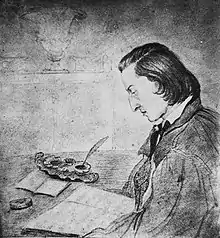Fantaisie in F minor (Chopin)
The Fantaisie in F minor, Op. 49, by Frédéric Chopin is a single-movement work for the piano, composed in 1841, when he was 31 years old.[1] From Chopin's letters it is known that he used the name "fantasy" to show some sort of freedom from rules and give a Romantic expression.[1] Frédéric Chopin continued the tradition of a self-contained movement in his Fantaisie.[2] This Fantaisie is one of Chopin's longest pieces, and is considered one of his greatest works.[3]
| Fantaisie in F minor | |
|---|---|
| by Frédéric Chopin | |
 Frederic Chopin in 1841, pencil drawing by George Sand | |
| Catalogue | Op. 49 |
| Genre | Romantic |
| Form | Fantasy |
| Composed | 1841 |
| Movements | 1 |
Form
This work belongs to the Fantasy form, a composition free in form and inspiration.[2] It begins with a solemn marching theme that eventually plunges into a passionate and virtuosic section, the transition marked poco a poco … doppio movimento, still with elements of marching, but more triumphant and positive in mood. About halfway through the piece occurs a slow and sombre chorale-like section in B major, before the previous section is restated. After a short, quiet and sweet statement followed by a final flourish the work ends in a plagal cadence in A-flat major, the relative key. This piece is 11-14 minutes long.
References
- "Fryderyk Chopin - Information Centre - Fantasy in F minor, Op. 49 - Genres". en.chopin.nifc.pl. 2012. Retrieved 23 May 2012.
- "fantasia (music) -- Britannica Online Encyclopedia". britannica.com. 2012. Retrieved 23 May 2012.
composition free in form and inspiration, usually for an instrumental soloist
- Samson, Jim (1992). "Extended forms: the ballades, scherzos and fantasies". In Samson, Jim (ed.). The Cambridge Companion to Chopin. Cambridge University Press. pp. 101–123. ISBN 9780521477529.
External links
- Fantaisie, Op.49: Scores at the International Music Score Library Project
- Performance of Fantaisie in F minor by Cecile Licad from the Isabella Stewart Gardner Museum in MP3 format